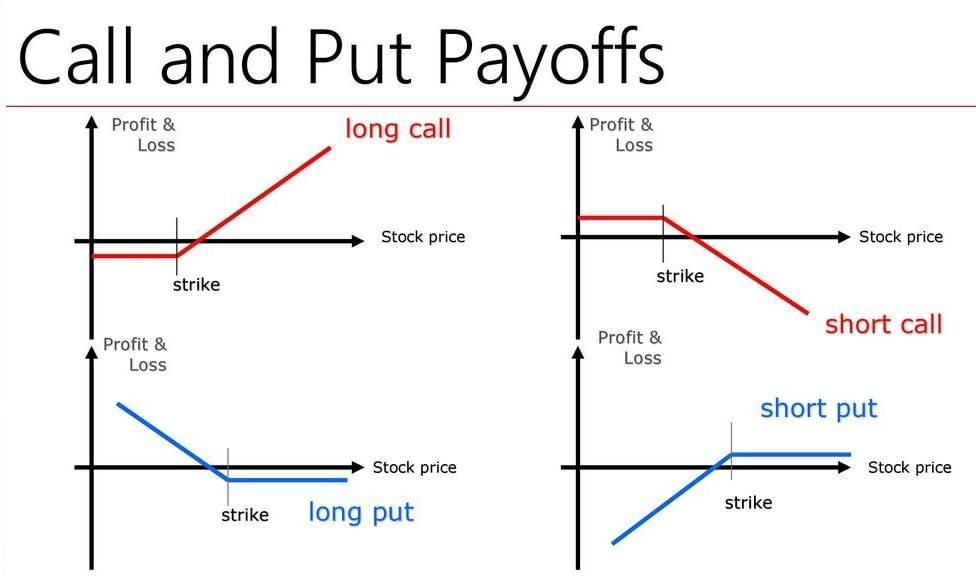Introduction
Imagine you’re at a football game. You’re confident your team will win, but a friend tells you they have an unusual bet: they can get paid if the score is close, even if their team loses. This is a lot like what options trading does. It’s not about predicting whether a stock will go up or down; it’s about betting on the magnitude of that movement. In options trading, “call” and “put” are the two core tools you use to make these bets.

Image: www.realvision.com
Now, imagine yourself as a trader, not a fan. Instead of a football game, you’re looking at a company’s stock price. You might use call and put options to profit from price fluctuations, hedge against risk, or participate in market movements without buying the underlying stock itself. This article will guide you through the fundamentals of call and put options, highlighting their capabilities and limitations.
Understanding Call and Put Options: The Basics
Call and put options are contracts that grant you the right, but not the obligation, to buy or sell a specific stock, called the underlying asset, at a predetermined price (the strike price). They’re like a temporary insurance policy for your stock positions.
Call Options
Think of a call option as a “buy” button. It gives you the right to purchase a stock at a fixed price in the future, even if its market price has risen. Essentially, you’re betting on the stock price going up.
Put Options
A put option is the opposite. It’s like a “sell” button. You have the right to sell a stock at a set price in the future, even if its market price goes down. You’re betting on the stock price falling.

Image: libertex.com
The Power of Leverage
Options trading offers leverage, meaning you can control a larger quantity of stock with a smaller investment. This can be incredibly beneficial for maximizing profits but also amplifies potential losses.
Let’s illustrate. If you purchase 100 shares of a stock directly, you need a substantial investment. With a call option, you might only need to pay a fraction of the cost to control those 100 shares. Your potential profit is amplified, but so is your risk.
Time Value and Expiration
Options contracts have a specific expiration date. This is crucial because time affects their value – they decay as they approach expiration, a concept known as “time decay.”
If the underlying asset doesn’t move as you predicted, your option might expire worthless. This is why understanding the expiry date is crucial. It significantly impacts your trading strategy.
Using Call and Put Options: Strategies
Covered Call
This strategy involves selling a call option while owning the underlying stock. You generate income from the premium but limit your potential upside in case the stock price skyrockets.
Protective Put
This strategy involves purchasing a put option to protect your existing stock portfolio. If the stock price falls, the put option provides a safety net, limiting your losses.
Latest Trends in Options Trading
Options trading has grown tremendously in popularity, fueled by factors like increased retail participation and the rise of online platforms. The market has witnessed a surge in volatility, making options even more attractive as a means to hedge or capitalize on price swings.
We are seeing the emergence of new options trading strategies and tools designed to meet the needs of a diverse range of investors. Moreover, the increasing reliance on Artificial Intelligence (AI) and advanced analytics is reshaping the landscape, offering more sophisticated tools for prediction and analysis.
Expert Tips for Options Trading
Do Your Research
Thorough research is paramount. Don’t just blindly buy calls or puts. Understand the underlying asset, its potential for volatility, and its current market conditions.
Manage Risk Carefully
Options trading involves inherent risk. Don’t risk more than you can afford to lose. Use stop-loss orders to limit potential losses and consider diversifying your portfolio.
Frequently Asked Questions (FAQ)
Q: What does “intrinsic value” mean in options?
A: It’s the difference between the strike price and the underlying asset’s current market price. A call option with an intrinsic value of $5 means the stock price is $5 above the strike price.
Q: What is a premium?
A: Premiums are the price of an option contract. They fluctuate based on the underlying asset’s volatility, the time to expiration, and the strike price.
Q: Can I use options for passive income?
A: Yes, strategies like covered calls can generate income through premium collection. However, it’s worth noting that there’s a trade-off since you’re limiting your potential upside.
Q: Are options trading for everyone?
A: Options trading is complex, requiring significant knowledge and risk tolerance. It’s not for everyone. If you are a beginner, it’s best to educate yourself thoroughly and maybe consider using a simulated trading account to practice before risking real money.
Call And Put In Option Trading
Conclusion
Call and put options offer a versatile tool for managing risk and potentially maximizing returns in the stock market. From leveraging price movements to hedging against losses, understanding these instruments can unlock opportunities for experienced and beginning traders alike. Remember, thorough research, careful risk management, and continuous learning are crucial for success in the exciting, and often volatile, world of options trading.
This article has highlighted some of the key aspects of call and put options – but this is just the beginning of your learning journey. Are you ready to dive deeper into the world of options, exploring strategies and managing risks? Let us know in the comments below!






